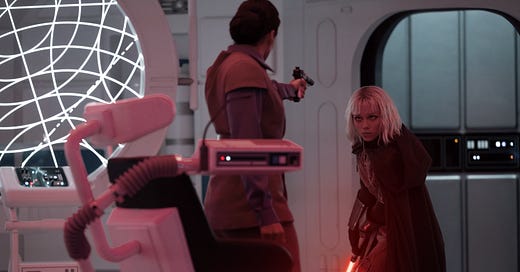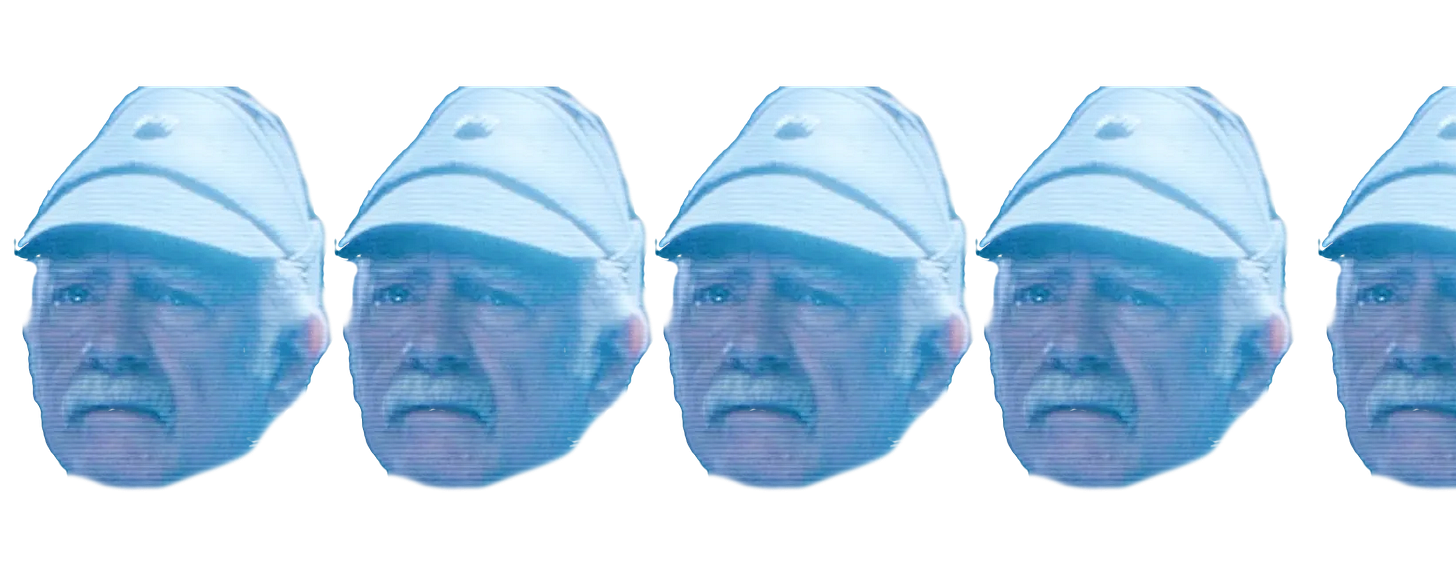Our own universe is expanding. For the past four years, the Star Wars universe has been shrinking.
Star Wars began to feel claustrophobic during The Mandalorian season 2, when a series of cameos—Bo-Katan Kryze, Boba Fett, Luke Skywalker—gave the impression the entire population of the galaxy far, far away could fit in Jabba’s palace. (Then, for a brief panicked moment watching The Book of Boba Fett, I thought they literally would.)
One of those cameos was Rosario Dawson’s debut as Ahsoka in an otherwise excellent Kurosawa riff, “Chapter 13: The Jedi.” Now, ironically, the T.V. show that episode teed-up may be doing the opposite, restoring some much-needed mystery. (Spoilers for Ahsoka follow.)
In “Chapter 13: The Jedi,” Ahsoka captures Morgan Elsbeth (Diana Lee Inosanto) and interrogates her about the location of Thrawn. Ahsoka kicks off with Elsbeth being sprung from jail by Jedi-turned-mercenary Baylan Skoll (the late Ray Stevenson) and his padawan, Shin Hati (Ivanna Sakhno).
The first hints of Elsbeth’s backstory immediately transport the story lightyears away from the now-never-ending Skywalker vs. Palpatine battle. Elsbeth turns out to be a Nightsister, one of the surviving Witches of Dathomir. Along with the mysterious, masked Marrok (wielding the signature helicopter lightsaber of the inquisitors), our bad guys are a strange mélange of Force users, all refreshingly outside the neat boxes of Sith and Jedi.
Introduced in the 1994 novel The Courtship of Princess Leia, the Nightsisters were added to canon by George Lucas as part of the backstory of Darth Maul. After an Original Trilogy in which only dudes (albeit sometimes short green ones) wielded the force, author Dave Wolverton wanted to create a band of cool female mystics. In the Clone Wars and Rebels cartoons, these witches can be seen summoning spooky magic with signature puffs of lime green smoke.
Mercifully, nothing smokes in the first two episodes of Ahsoka except the severed head of an assassin droid. Dave Filoni is importing a cartoon universe into live action, and has to be judicious about not doing anything too goofy too soon. Alluding to the existence of witches (the title of Episode 2 is “Toil and Trouble”) without borrowing any special effects from the Goosebumps movies seems like a good way to thread that needle.
This balancing act also results in the best-ever blend of Prequel and Original Trilogy aesthetics in live-action Star Wars. Set between Revenge of the Sith and A New Hope, Rogue One and Andor made perfunctory attempts at this trick. (Remember the clone tank transporting Jyn to a work camp?) But it’s easier for Andor, which avoids both the Jedi (understandably) and aliens (frustratingly) in an attempt to stay grounded. Ahsoka is a show led by an alien Jedi—unmistakably a prequel-era character driving a Coruscant-styled spaceship—blending seamlessly into a post–Return of the Jedi setting.
This synthesis makes thematic sense, too. Ahsoka Episodes 1 and 2 present a Republic trying to revert to its pre-Empire days. (The great Clancy Brown reprises his animated role as Governor Azadi on a cleaned-up Lothal, the planet from Rebels.) But the New Republic government is clearly having some problems with Imperial denazification.
In our first episode, Ahsoka finds a map to Thrawn, and then the bad guys steal said map from Ahsoka’s former apprentice Sabine Wren (Natasha Liu Bordizzo). Sabine’s force-sensitivity was a subject of much debate during the show’s pre-release marketing. But as explained by Huyang (David Tennant), the ancient Jedi temple droid that accompanies Ahsoka everywhere, Ahsoka took Sabine on as an apprentice despite her being on a low-percentile in Force sensitivity.
This democratic view of the force—in which everyone has a certain degree of connection to it—was suggested in The Last Jedi, but clawed back in The Rise of Skywalker, when Rey was infamously revealed to be the granddaughter of Gandalf the Grey. Imagine an x-axis labelled “lightsaber skill” and a y-axis labelled “Force sensitivity,” and you can already plot this show’s heroes and villains all over the place. It’s a nice break from the usual portrayal of sword-fighting as just another genetic Jedi superpower.
The second episode centers around Ahsoka and Hera Syndulla (Mary Elizabeth Winstead) investigating Elsbeth in an attempt to get the map back. They inspect her former factories on the ship-building hub Corellia (homeworld of Han, Qi’ra, and Wedge), and find a facility crawling with Imperial loyalists, secretly shipping Star Destroyer parts to Elsbeth so she can build a giant hyperdrive ring capable of retrieving Thrawn from “another galaxy.”
I don’t want to turn this review into chum for Sequel Trilogy haters, but the suggestion of a pro-Imperial conspiracy deep in the New Republic bureaucracy is a much stronger intro to something like the First Order than, say, Poe Dameron marveling at the inside of a hangar at the beginning of The Force Awakens.
But the interpersonal drama turns out to be as interesting as the machinery of Thrawn’s return. Even if you didn’t watch Rebels, the important stuff shines through: Sabine wants to reunite with Ezra, who pulled Thrawn to parts unknown. Ahsoka tried to take Sabine on as her padawan, but their similar personalities led to a falling out. Hera is the maternal figure trying to bring everyone together (and stop her droid from killing people).
I’m not crazy about the cartoons, but I still think the show is delivering on a basic formula most every Star Wars fan wants but somehow never gets: Strong live-action storytelling involving Jedi characters in big, mysterious universe. Andor was excellent, but somewhat self-conscious about being a Star Wars show. The Mandalorian was at its best as a small, self-contained story (and at its worst as anything else). The Sequel Trilogy, again, made the galaxy small.
But Ahsoka Tano is just a single operator in a bigger galaxy, one in which she needs a clearance code to board a New Republic capital ship to have a single classified conversation. And, as it turns out, this galaxy isn’t the only one. Thrawn is trapped in a galaxy far, far, far away. Hopefully it doesn’t take him a long, long time to show up.
The Rating
4.5 concerned holographic Captain Pellaeon heads out of five.
Random Thoughts
The MacGuffin looks like the snitch from Harry Potter.
“Thrawn calls to me across time and space.” —Morgan Elsbeth. Same, sis.
Ahsoka does a Scooby-Doo move, pulling the assassin droids through a series of holes, and manages to make it look cool.
I love the idea that lightsaber hilts can be used like fingerprints to identify Jedi.
#VantoWatch
As a Thrawn fan, I am keeping a close eye on whether the boy Eli Vanto seems destined to appear in the show.
Thrawn is supposedly in another galaxy. The Unknown Regions, containing Eli and the rest of Thrawn’s species, is typically mapped as existing on the edge of the main galaxy. But geography is fuzzy in Star Wars. And given that Thrawn was presumed dead, clearly he has not had a ton of contact with the Imperial remnant or New Republic. He could be doing anything out there! Hope springs eternal.







Ppl saying Ezra is Marrock is crazy. No way would he written as some thug with a face reveal later